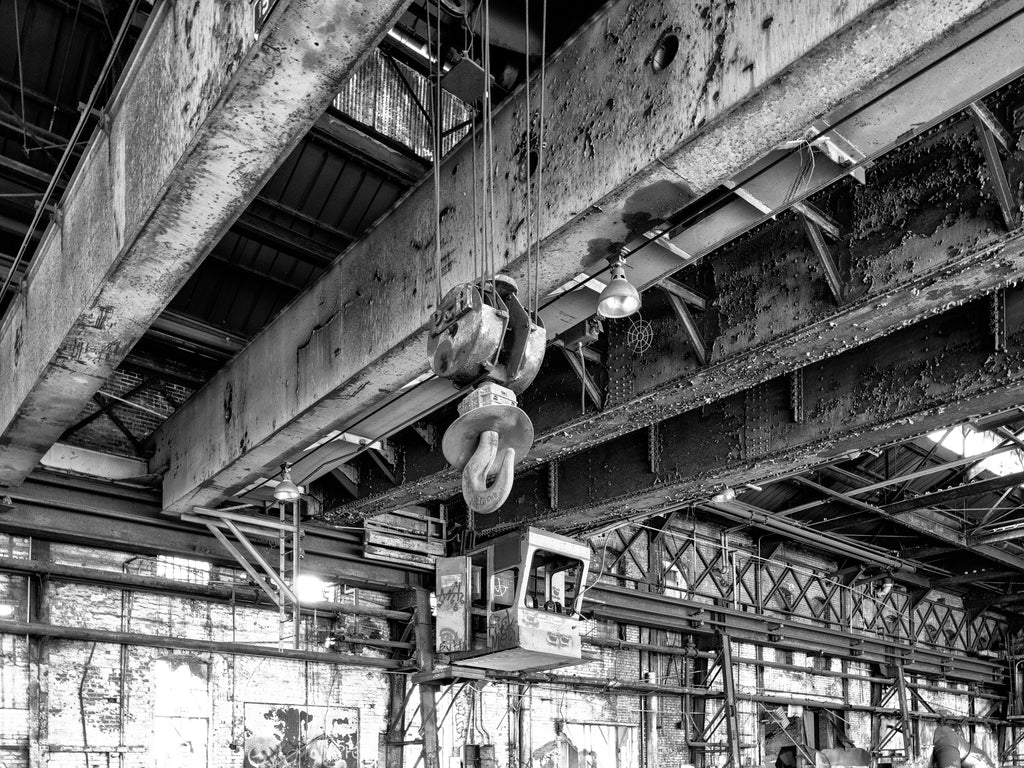
Fine art photographer Keith Dotson was granted access to the vast, historic foundry in its final days prior to demolition
Photographer Keith Dotson managed to secure permission to photograph the abandoned Wheland Foundry in the South Broad District of Chattanooga in its final days.
Endangered Buildings
Built in 1936 and abandoned since 2003, the Wheland Foundry building has long been considered a nuisance and an eye sore by many in Chattanooga, while others consider it to be an important part of the city’s history.
The plant manufactured auto parts for the Detroit auto makers, and contributed to the war effort in WWII by making parts for the military. For many years, it operated around the clock, paying a good wage with benefits to Union workers in dirty and sometimes dangerous conditions.
For Keith Dotson, the massive and menacing specter of the abandoned building had long been a focus for fascination, but a place he had never managed to photograph.
Many plans for reuse or redevelopment of the site have fallen-through over the decades. But in early 2024, approval of funding for a new mixed-use development project assured the demolition of the massive plant to make way for a new stadium for the Chattanooga Lookouts — a double-A minor league baseball team affiliated with the Cincinnati Reds.
According to a press release, the deal will mean redevelopment of 140 acres of Chattanooga's post-industrial South Broad District, including Wheland Foundry and also the nearby U.S. Pipe site, another abandoned mill.
It appears that some of the historic structures will be preserved, including Wheland's brick Power House building, but the industrial sites are considered brownfields and will need substantial environmental cleanup and demolition work in preparation for the new development.
History of Industrial Pollution
Chattanooga's industrial history brought with it much environmental contamination. In 1969, legendary American news anchor Walter Cronkite called Chattanooga the dirtiest city in the country.
The city was once home to 50 metal foundries churning smoke and soot into the air alongside the Tennessee River.
One former employee of the Wheland facility who worked in the payroll office, called the facility "a dirty, nasty and dangerous work environment," even for the office workers. He described the air as filled with hazardous chemicals and toxic odors, and said you could see metallic particles floating around, flickering in shafts of sunlight. He said that even though he worked in an office, away from the most toxic production areas, the desks would be covered every morning with a thin layer of soot that had somehow seeped around the locked office door.
Since those days, Chattanooga has come a long way in cleaning up, but some polluted industrial areas like the Wheland site still remain.
Turning Industrial Ruins into Art
As a photographer, Keith Dotson's goal was to somehow turn the brooding industrial ruins into art, and to do it quickly. He only had access to the site for a short window of time.
Black and White Photographs
All of these photographs are offered as museum-quality fine art prints in a wide variety of sizes, from small to mural size, on the very finest art papers available.
Ruins of the Old Wheland Foundry in Chattanooga - Black and White Photograph by Keith Dotson. Click here to buy a fine art print.









Comments
Arnold Dove:
Very touching photos from days gone by and a time that is seemingly forgotten.I was one of many that worked at Wheland Foundry throughout its long and storied history. I started out working in the basement shoveling sand. I worked shakeout for a little while, however my desire was to be an “iron pourer” which I did!
I poured iron on loops 5, 6 and 3. It was a hot yet rewarding job. To see the huge piles of scrap metal brought in along with the tons of limestone rock, being melted together from a recipe of perfected ingredients. Those molten ingredients which made cast iron that I would pour into a mold forming a brand new brake drum for the automobile industry! Something that was discarded made anew and I had a hand in it!
I have many memories of Wheland and friends I made there a long the way. Thank you for sharing the photos, they brought back many of those memories.
Arnold Dove (Loop 3,5 and 6 iron pourer)
Mar 02, 2025
Aaron Meriweather:
What product was manufactured at Wheland, and when did it shut down?
Dec 13, 2024
Angela F:
OMG…. I am so envious. I passed by this in April this year and was hoping to be able to go back and get some black n white pics. My heart is broken.
You got some great pictures though.
Oct 01, 2024
Antoine:
Hi, friend.
Beautiful photos with a wonderful story behind it.
Not only the written story but also the narrative factor in the photos is very powerful.
Antoine.
Aug 05, 2024
Leave a comment